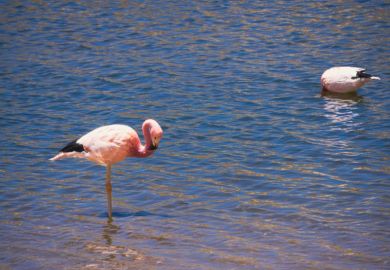In 1864, the pioneering science fiction writer Jules Verne imagined in Journey to the Centre of the Earth a fantastic array of life deep underground, from forests of giant mushrooms to plesiosaurs splashing in subterranean seas. In recent decades, science has been catching up, providing the dawning realisation that the ground beneath our feet does indeed harbour a whole host of previously unimagined life. The crust of planet Earth is alive with hardy microorganisms, thriving in its dark, hot depths. And Tullis Onstott has been at the forefront of the exploration of its subterranean mysteries. If you had to compare him to an iconic figure, I don’t think that you’d go far wrong seeing him as a microbiologist Indiana Jones, clambering through dimly lit mining tunnels far below the surface, sampling tubes in hand. In Deep Life, he takes us with him on his adventures: 3.2 kilometres (2 miles) underground in South African gold mines, in an ancient seabed deep beneath the desert landscape of the American Southwest and below the frozen wastelands of the Arctic tundra. The stunning realisation he shares is that this deep, dark biosphere probably holds more living matter in it than all of the sunlit surface and oceanic ecosystems of the Earth.
Deep Life covers 25 years of Onstott’s illustrious career as a “subterranaut”, starting in 1986 and the very beginnings of the department of the environment’s subsurface science programme that coupled microbiologists with industrial mining operations, to 2009 and the discovery of “the worm from Hell” found living without oxygen a kilometre underground. Along the way, he addresses some of the deepest questions – if you’ll excuse the pun – in modern biology: just how far down could life survive? Might cells be living off radiation released by the surrounding rock? Could life itself have originated in the deep subsurface? And what does the incredible subterranean extent of terrestrial life tell us about the possibility of organisms on other planets and moons?
At times, Onstott’s descriptions are as beautifully evocative as those in the best novels. While exploring a tunnel half a kilometre underground, used to mine the potash laid down about a quarter of a billion years ago as an ancient sea evaporated, he recounts: “The salt was remarkably clear. We took the lights off our hard hats, placed them against the tunnel wall, and peered inside the salt bed to see the light reflecting off the three-dimensional relict textures of a Permian seafloor. I peered into the salt beds as I scanned my headlamp around as if I was scuba diving across the Permian seabed. Could it be that within this congealed seawater, halophiles [extremely salt-tolerant organisms] still breathed? Was ours the first light that their pigments had detected since they were buried alive 250 million years ago?”
But for me, these few sparkling nuggets end up lost in the book’s surrounding bedrock, a densely detailed and dry chronological account of mines visited, meetings attended and other researchers encountered. Many of the best popular science books are written by researchers in the forefront of the field and deliver an alluring narrative of the trials and tribulations of modern science and the thrill of discovery. But this requires a particular knack for storytelling and focusing on the interesting details for a lay audience and, for me, Deep Life doesn’t quite deliver on this potential. It offers great insights for science historians or students in the discipline, but not the heady adventure tale it could be for general readers.
Lewis Dartnell is professor of science communication, University of Westminster, and author of The Knowledge: How to Rebuild our World from Scratch (2014).
Deep Life: The Hunt for the Hidden Biology of Earth, Mars, and Beyond
By Tullis C. Onstott
Princeton University Press, 512pp, £24.95
ISBN 9780691096445 and 9781400884247 (e-book)
Published 16 November 2016
POSTSCRIPT:
Print headline: Going over to the dark side
Register to continue
Why register?
- Registration is free and only takes a moment
- Once registered, you can read 3 articles a month
- Sign up for our newsletter
Subscribe
Or subscribe for unlimited access to:
- Unlimited access to news, views, insights & reviews
- Digital editions
- Digital access to THE’s university and college rankings analysis
Already registered or a current subscriber?




